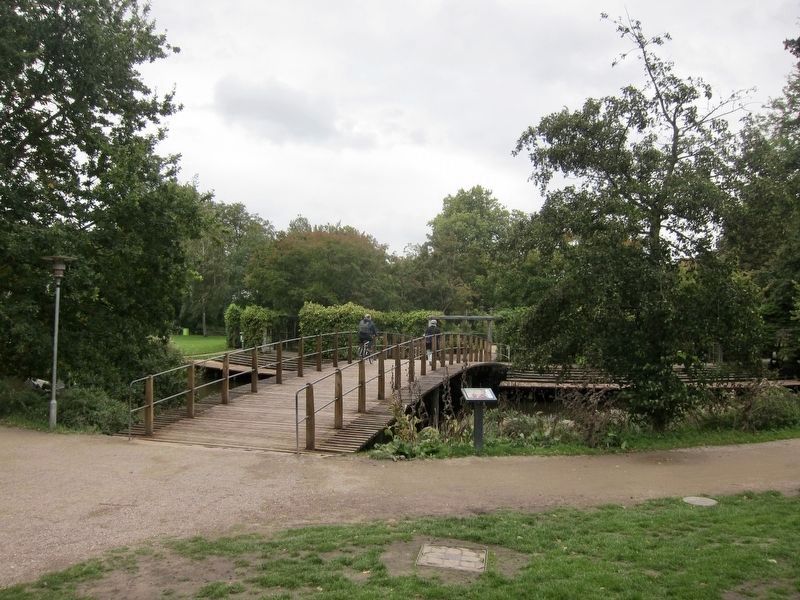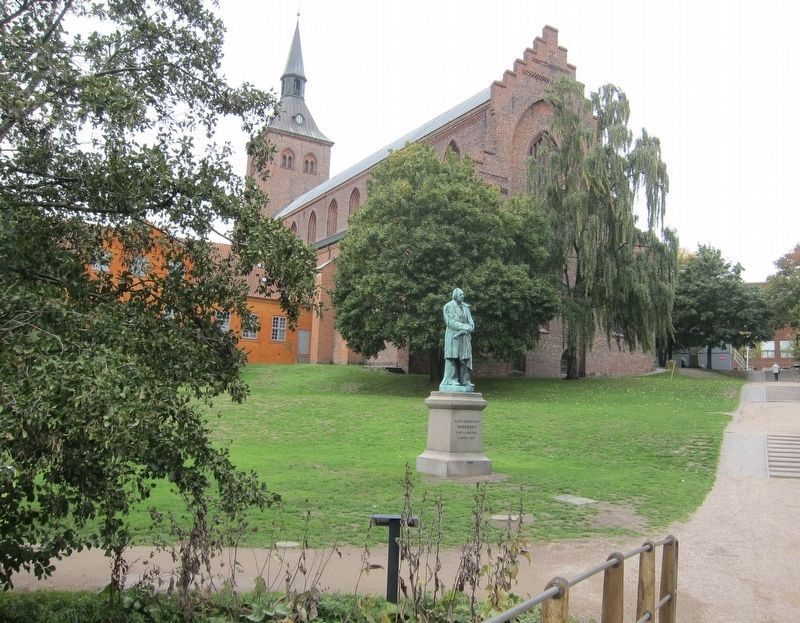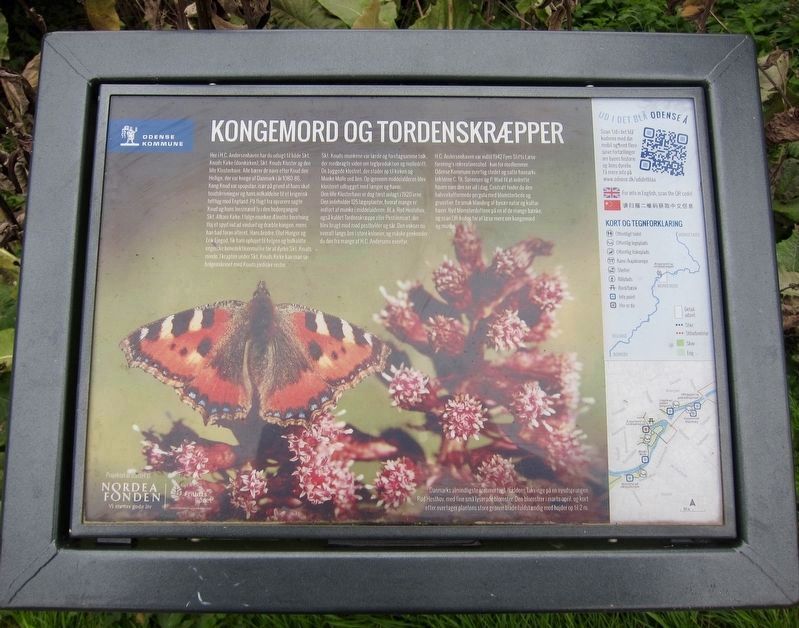Kongemord og Tordenskræpper / Royal Murder and Red Butterbur
Skt. Knuds-munkene var lærde og foretagsomme folk, der medbragte viden om teglproduktion og molledrift. De byggede klostret. der stoder op til kirken og Munke Molle ved åen. Op igennem middelalderen blev klosteret udbygget med længer og haver. Den lille Klosterhave er dog forst anlagt i1920-erne. Den indeholder 125 lægeplanter, hvoraf mange er indfort af munke i middelalderen. Bl.a. Rod Hestehov,
også kaldet Tordenskræppe eller Pestilensurt, der blev brugt mod mod pestbylder og sår. Den vokser nu overalt langs åen i store kolonier. og måske genkender du den fra mange af H.C. Andersens eventyr.H.C. Andersenhaven var indtil 1942 Fyns Stifts Læse-forenings rekreationssted - kun for medlemmer. Odense Kommune overtog stedet og satte havearki-tekterne C. Th. Sorensen og P. Wad til at indrette haven som den ser ud i dag. Centralt finder du den halvcirkelformede pergola med blomsterbede og grusstier. En smuk blanding af bynær natur og kultur-haver. Nyd blomsterduftene på en af de mange bænke, og scan QR-koden for at læse mere om kongemord og munke.
-
Here in the H.C. Andersen Garden one has a view of St. Knuds Church (cathedral), St. Knuds Monastery, and the small monastery garden. All bear the name of Knud the Holy, who was the King of Denmark in the years 1080-86. King Knud was unpopular, especially because of his tax policies and his call for aggression against England. On the run from rebels, Knud and his followers sought shelter in the defunct St. Albani Church. According to the monk Ælnoth's account, a spear flew through the window and killed the king as he prayed in front of the altar. His brothers, Oluf Hunger and Erik Ejegod, had him canonized and called on the English Benedictine monks to cultivate St.
The monks of St. Knuds were learned and enterprising people who brought knowledge about brick production and milling. They built the monastery by the river, standing next to the church and the Monks' Mill. During the Middle Ages, the monastery was extended and gardens were added. The little monastery garden, however, was first built in the 1920s. It contains 125 medicinal plants, many of which were introduced by the monks in the Middle Ages, including, amongst others, Red Butterbur, also known as Thundercrack or Pestilence, which was used against pests and wounds. It now grows everywhere along the river in large colonies, and perhaps one may recognize it from many of H.C. Andersen's tales.
Until 1942, the H.C. Andersen Garden was the Fyns Foundation Reading Society's recreational site - for members only. The municipality of Odense took it over and had the pieces of art by Carl Th. Sorensen and P. Wad installed to decorate the garden as it looks today. In the middle one may enjoy the semi-circular pergola with flower beds and gravel paths - a beautiful blend of nature and cultural gardens. Enjoy the flower fragrances on one of the many benches and scan the QR code to read more about regicide and monks.
Erected by Odense 
Topics. This historical marker is listed in these topic lists: Notable Events • Parks & Recreational Areas. A significant historical date for this entry is July 10, 1086 CE.
Location. 55° 23.702′ N, 10° 23.398′ E. Marker is in Odense, Syddanmark (Southern Denmark), in Odense Kommune. Touch for map. Marker is in this post office area: Odense, Syddanmark 5000, Denmark. Touch for directions.
Other nearby markers. At least 8 other markers are within walking distance of this marker. Grønbenet Gakket Gangart / Washladies, Water Sprites, and Waddlers (about 210 meters away, measured in a direct line); Munke Mølle / Monks' Mill (about 240 meters away); Hans Christian Andersen - School (about 240 meters away); The Oldest Kingdom of the World (approx. 0.3 kilometers away); Ambrosius Stub (approx. 0.3 kilometers away); Nonner på Vikingborgen / Nuns at the Viking Fortress (approx. 0.3 kilometers away); Ølbryggeri Og Gelændergaranti / A Beer Brewery and the Guaranteed Railings (approx. 0.3 kilometers away); Hans Christian Andersen at Vestergade 57-59 (approx. 0.4 kilometers away). Touch for a list and map of all markers in Odense.
More about this marker. The marker is located in Eventyrpark (H.C. Andersen Garden), roughly in the center of the park, on the north side of the bridge that leads to a small island in the middle of the river.
Also see . . .
Canute IV of Denmark (Wikipedia). "Canute IV (c. 1042 – 10 July 1086), later known as Canute the Holy (Danish: Knud IV den Hellige) or Saint Canute (Sankt Knud), was King of Denmark from 1080 until 1086. Canute was an ambitious king who sought to strengthen the Danish monarchy, devotedly supported the Roman Catholic Church, and had designs on the English throne. Slain by rebels in 1086, he was the first Danish king to be canonized. He was recognized by the Roman Catholic Church as patron saint of Denmark in 1101." (Submitted on February 26, 2019.)
Credits. This page was last revised on February 26, 2019. It was originally submitted on February 26, 2019, by Andrew Ruppenstein of Lamorinda, California. This page has been viewed 114 times since then and 11 times this year. Photos: 1, 2, 3. submitted on February 26, 2019, by Andrew Ruppenstein of Lamorinda, California.
